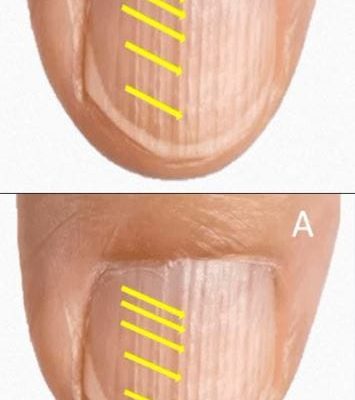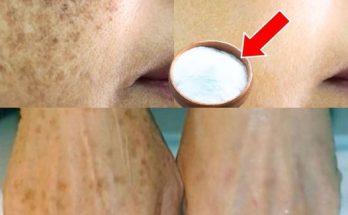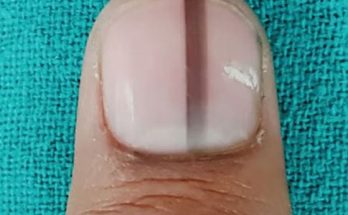We know that the nail plate is made up of nail plate cells, linked together by desmosomes & anchor knots.
These nail plate cells can be split into 3 groups: about 10% are made by the dorsal matrix, around 80% from the ventral matrix, and about 10% from the distal matrix or lunula.
If all is well, all these different nail plate cells are bound together in such a way that we don’t even notice they are different. Our nail plates look smooth & are strong. They can withstand almost all artificial nail products if we, as nail professionals, take good care not to damage them during or after product application or removal.

The problem begins when changes happen either in the production of nail plate cells or when they are being transported along the eponychium on their journey under the proximal nail fold or the desmosomes & anchor knots are defective.
Let’s have a look at Excessive Porosity.
What does ‘porous’ mean?
According to the Oxford Dictionary, porous means: “Having minute interstices (a very small space) through which liquid or air may pass”.
Our nail plates are porous when they are in a normal or healthy state. Just not for all fluids. For instance, a water molecule can pass through the nail plate.
We see this if we have just had a long bath or been in the pool for a while. Our nail plates swell and become really flexible. Think of it as if our nail plates are a natural sponge. In a normal dry state, it is strong and doesn’t bend very well. But if we put that natural sponge in a bucket of water, we can squeeze it and bend it. That’s the bendy nail plate that we experience. Sometimes, this can even help us take care of excessively thick nail plates but… The water soon evaporates, and our nail plates return to their normal size and hardness. If the nail plate cells are normal and well taken care of (oil maintenance), we don’t notice it.
But …
If our nail plate cells are not being produced as they should be, we might see a nail plate that looks like this ‘Open beaded ridge’ nail plate.
If we look at nail plate A

The upper surface of the nail plate looks shiny & intact, but the nail plate looks like it has ‘little beads’ on the surface, hence the name. The surface of the nail plate is still intact – the light reflects off it, it has ridges, but they are closed and intact, the surface is strong.
If we are going to choose an artificial nail product for this nail plate, we want to use:
1. A product that soaks off well, with a well-known nail treatment in the nail plate first or
2. A more permanent product like L&P or Acrygel.
Why? Because if we start scraping at the top of the groves with our cuticle pusher then we will tear up the nail plate & cause even more problems. Plus, without proper nail plate maintenance with a good quality oil, we might even create a breading space for White Superficial Onychomycosis which is what happened here.

If we look at nail plate B
‘Open Beaded Ridge’ nail plate (yellow arrows) & hang nail (blue arrow), with normal growth (remember on average a nail plate grows 1mm a week). Where the nail plate is younger & under the least amount of pressure from the lateral nail folds (green arrows),the nail is smoother. The nail plate cells towards the free edge are much older, so they cannot keep up with the wear & tear of daily nail life.
This nail plate has grooves, like nail plate A, and a similar beaded effect, but the beads are unraveled, hence the name ‘open beaded ridge nail plate’. These nail plates are a nail technicians’ worst nightmare. Now we need an artificial nail product that adheres to the nail so well that the open ridges won’t cause a problem. The products with the best adhesion usually contain the most aggressive allergens so proceed with caution. Most standard nail products will not adhere to this nail plate for the normal amount of time. Even using a well-known product that we bring into the nail plate, it is on its own, not enough to get these nail plates under control.
Let’s put the 3 different nail plates together:

Let’s get back to porous & why it’s important to recognize it.
The first nail plate (healthy) will absorb any solvent, and that solvent will evaporate without any problems at all.
Porosity of a nail plate happens because, as we get older, the cells get larger, and they start to function abnormally. Nail plate cells become larger, less compact. This causes rifts in the nail plate structure. Additionally, as we age, the nail matrix loses its collagen, and therefore we experience loss of elasticity to the nail. During our daily lives, washing our hair, taking a shower, swimming etc., our nail plates expand and contract. They are also in perpetual motion 24/7. So, these larger cells that are weaker start to rip apart. You can see this in the nail plate of photo B.
Nail plate A: Will absorb any solvent and swell. This can cause a problem during product removal. In any case, if we get a little too heavy-handed with our cuticle pusher, we can create even more problems. When the nail plate reverts back to its original dry state, little cracks appear.
Nail plate B: Will absorb any solvent causing the nail plate to swell. When the solvent evaporates, the beads will be torn a little more. When the nail plate reverts back to its original dry state, little cracks appear, and the nail plate condition worsens.
Nail Plate C3: Will absorb any solvent, including water, hold it longer than a non-porous nail plate & assist pseudomonas aeruginosa in its development in the nail plate itself. Pseudomonas loves warm, humid, dark spaces. (eg. underneath your artificial nail coating)
Nail plate C: Will absorb any solvent, including water, hold it longer than a non-porous nail plate. If your client is susceptible to White Superficial Onychomycosis, then it will happily develop. It too loves warm, humid, dark spaces. (eg. underneath your artificial nail coating)
But there is more:
If we ignore the condition of the nail plate and we don’t improve it before application another problem is waiting for us.

C2: Nail plate recovery before artificial nail plate application with a product that we bring IN the nail plate
Pseudomonas Aeruginosa

Photo C3 shows the Beaded Ridges really well. Per definition, these are more porous nail plates but now with the added bonus of a bacterial infection. Pseudomonas Aeruginosa loves porous nail plates that are not properly maintained with a good quality oil & lotion.
Underneath your artificial nail product, with the help of porous nail plates, pseudomonas can cause havoc. Recovery can take a really long time. This salon clients’ nails grew just 7mm in 7 months!
In special situations, the nail plate may need to be removed (which is never a good thing, and something we only do with fingernails), if a medical doctor requests it. This is a very rare occurrence but it could be a case where, for example, the client is about to undergo chemotherapy. In such a case, pseudomonas is life threatening, and needs to be dealt with before therapy begins.
As first aid advice
You can advise your client to wash their hands with soap & water, then rinse their nails in a clear vinegar and water solution (mixed at a 1:1 ratio). Then dry well, and apply a good quality oil. This changes the living environment that pseudomonas loves so much to one where it no longer can happily exist. Remember to refer your client to their GP to prevent further complications.

Artificial nail product manufacturers create products to give us service longevity. That is better for our salons and for our clients. However, it is our job as nail professionals to realize that a product that may suit a perfect nail plate that’s not porous is not the product that we need for nail plate A, for example. And it is definitely not the product for nail plate B!
Looking at the condition of the nail plates of our clients BEFORE we agree to a service is important. Just as important, if not more so, it is important to measure the growth of your client’s nail plate. That way you can:
A: Plan the new appointment at the right time for your clients’ nails, not her wallet.
B: You won’t promise amazing results in a couple of weeks because some nail plates just don’t move at the rate of 1mm a week!
Porous nail plates need constant maintenance, oil, hand washing with soap & water, more oil, and maybe some lotion. More important than that, we need to bring porous nail plates up to optimal condition BEFORE we apply artificial nail product! We also need to apply the right nail product to and for the nail plate in front of us, not the product we have on the shelves. Additionally, our clients need to be aware of the value of nail unit maintenance with oil and lotion.
A porous nail plate without artificial nail products will seldom suffer from any kind of infection, fungal or bacterial.



